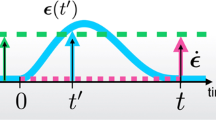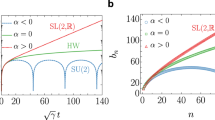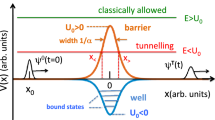Abstract
IT has recently been pointed out by Kramers and Heisenberg1 that from the knowledge of the collision cross-sections between free particles, the energy-levels of the discrete states can be deduced. For this purpose the asymptotic wave function in the continuous spectrum (for one particle under the influence of a fixed centre of force), is considered, where Sl is the diagonal form of the S-matrix and a function of the real momentum k. The stationary states follow then from the condition k = ix, and and, for relativistic particles, It is evidently necessary that x < m. The upper half of the k-plane (x < 0) gives only a repetition of the same physical facts if the roles of zeros and poles of S are interchanged.
This is a preview of subscription content, access via your institution
Access options
Subscribe to this journal
Receive 51 print issues and online access
$199.00 per year
only $3.90 per issue
Buy this article
- Purchase on Springer Link
- Instant access to full article PDF
Prices may be subject to local taxes which are calculated during checkout
Similar content being viewed by others
References
Several as yet unpublished papers by Heisenberg. A complete account of them is given by Møller, ref. 2.
Møller, Kgl. Danske Vid. Sels. Math-Fys. Medd., 23, No. 1 (1945); 22, No. 19 (1946); Nature, 158, 403 (1946).
Heitler and Hu, Proc. Roy. Irish Acad., in the press.
Author information
Authors and Affiliations
Rights and permissions
About this article
Cite this article
HEITLER, W., HU, N. Interpretation of Complex Roots of the S-Matrix. Nature 159, 776–777 (1947). https://doi.org/10.1038/159776a0
Issue Date:
DOI: https://doi.org/10.1038/159776a0
This article is cited by
-
Zu notwendigen Resonanzkriterien im station�ren Einkanal-Fall
Zeitschrift f�r Physik A Atoms and Nuclei (1975)
-
On the physical interpretation of complex poles of theS-matrix - I
Il Nuovo Cimento (1960)
-
Zur Theorie der zerfallenden Zust�nde
Zeitschrift f�r Physik (1956)
Comments
By submitting a comment you agree to abide by our Terms and Community Guidelines. If you find something abusive or that does not comply with our terms or guidelines please flag it as inappropriate.



